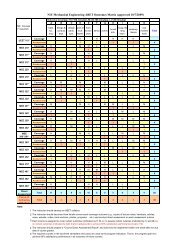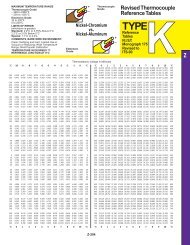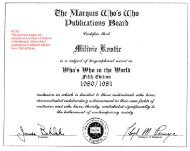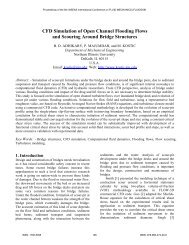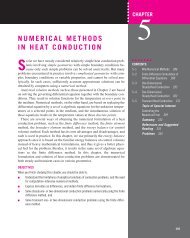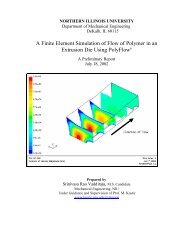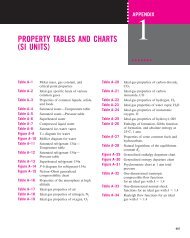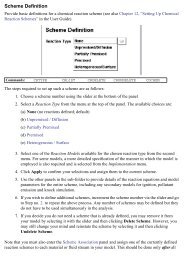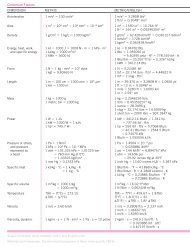Design of Extrusion Dies - Kostic - Northern Illinois University
Design of Extrusion Dies - Kostic - Northern Illinois University
Design of Extrusion Dies - Kostic - Northern Illinois University
Create successful ePaper yourself
Turn your PDF publications into a flip-book with our unique Google optimized e-Paper software.
636 <strong>Design</strong> <strong>of</strong> <strong>Extrusion</strong> <strong>Dies</strong><br />
devices that contact the extrudate melt, is presented<br />
later in the section ‘‘Extrudate Cooling and Sizing<br />
Hardware.’’<br />
SHEET DIES<br />
The most common extrusion die for sheet products is<br />
the coat hanger-type manifold die as shown schematically<br />
in Fig. 1A and as a section view in Fig. 1B. The<br />
key elements <strong>of</strong> Fig. 1A are:<br />
Central inlet port: connects to the extruder barrel.<br />
Manifold: provides a streamlined channel to evenly<br />
distribute the melt to the island.<br />
Island: with the manifold serves to create an equal<br />
pressure drop from the die inlet to all points across<br />
the die exit.<br />
Die lip: wide slit across the die that provides the<br />
final sizing <strong>of</strong> the melt.<br />
Commercial sheet dies typically employ four features<br />
to control the flow to the die lip. These are the<br />
combined shape <strong>of</strong> the manifold and the island as well<br />
as the following three features shown in Fig. 1B:<br />
Choker bar: adjustable along with the width <strong>of</strong> the<br />
die and serves to tune the flow balance across the<br />
width <strong>of</strong> the die.<br />
Lower lip: sets the nominal sheet thickness.<br />
Flex-lip: adjustable along the width <strong>of</strong> the die and<br />
provides the final tuning to create uniform flow<br />
across the die.<br />
In addition, sheet dies have die bolts that hold the<br />
upper and lower die plates together. The die plates<br />
are normally heated with cartridge heaters spaced<br />
along the width <strong>of</strong> the die. This type <strong>of</strong> die is typically<br />
made for a specific type <strong>of</strong> polymer to account for the<br />
shear thinning behavior <strong>of</strong> that polymer. [11] Consequently,<br />
the flow distribution in the die will change<br />
with melt viscosity, i.e., when the power law viscosity<br />
index <strong>of</strong> the resin changes. As the polymer grades<br />
change, flow adjustments can be made at the choker<br />
bar and at the flex lip, which both span the width <strong>of</strong><br />
the die and can be adjusted at numerous points along<br />
the width. Clam shelling, or die deflection, is another<br />
cause <strong>of</strong> nonuniform flow across the die. [13,14] The<br />
higher pressures along the centerline <strong>of</strong> the die coupled<br />
with the lack <strong>of</strong> bolting to keep the die plates together<br />
cause the centerline <strong>of</strong> the die gap to widen. Clam shelling<br />
can increase as the throughput <strong>of</strong> the die increases<br />
because <strong>of</strong> higher die pressures. Thus, the flow balance<br />
across the die will be sensitive to production rates.<br />
Innovations in automatic flow adjustments have been<br />
made with designs like the Auto-Flex sheet die where<br />
the die lip gap at the flex lip is automatically adjusted<br />
by changing the length <strong>of</strong> the flex lip adjustment<br />
bolts. [15,16] The temperature-controlled bolts change<br />
length in response to cross-machine scanning <strong>of</strong> the<br />
sheet thickness.<br />
FLAT FILM AND BLOWN FILM DIES<br />
<strong>Dies</strong> used to make film less than 0.01 in. thick include<br />
flat, slit-shaped dies called T-dies and annular dies<br />
for blown film (Figs. 2 and 3). The design <strong>of</strong> the<br />
T-die is similar to the coat hanger-type die with the<br />
exception that the manifold and the land length are<br />
constant along with the width <strong>of</strong> the die. Consequently,<br />
the use <strong>of</strong> T-dies is <strong>of</strong>ten limited to coating applications<br />
with low-viscosity resins that resist thermal<br />
degradation, as the ends <strong>of</strong> the manifold in the T-die<br />
create stagnation pockets. [13] A common application<br />
for a film die is to coat a substrate like paper.<br />
Blown film dies are the most common way <strong>of</strong> making<br />
commercial films. Because the blown film is so thin,<br />
weld lines are not tolerated, and the melt is typically<br />
introduced at the bottom <strong>of</strong> a spiral mandrel through<br />
a ring-shaped distribution system, as shown in Fig. 3.<br />
A series <strong>of</strong> spiral channels, cut into the mandrel-like<br />
multiple threads, smear the melt as it flows toward<br />
the die exit. This mixing action ensures that the melt<br />
is homogenous on exiting the die. Unlike other extrusion<br />
processes, blown film is sized and quenched from<br />
melt to solid film without contacting metallic cooling<br />
elements. The interior <strong>of</strong> the melt tube is pressurized<br />
with approximately 2 in. <strong>of</strong> water pressure. This pressure<br />
causes the tube to suddenly expand into a bubble<br />
as it exits the die. The tube forms a bubble because it is<br />
pinched overhead with nip rolls, which retain the air<br />
pressure. During the process <strong>of</strong> expanding, the melt<br />
tube undergoes an order <strong>of</strong> magnitude reduction in<br />
thickness and thus cools rapidly. This quenching<br />
moment occurs at the frost line <strong>of</strong> the bubble. The melt<br />
quenching occurs with a combination <strong>of</strong> external cooling<br />
air and internal bubble cooling air, as shown in<br />
Fig. 3. After the film passes through the nip rolls, it<br />
passes through a series <strong>of</strong> guide rollers to be wound<br />
up on to a roll.<br />
PIPE AND TUBING DIES<br />
Both pipe and tubing are made in dies with an annular<br />
die exit. A pipe product is defined as being greater than<br />
1 in. in outer diameter and a tube less than 1 in. <strong>Dies</strong><br />
for these products are made in two styles: 1) in-line<br />
dies (also called spider dies) shown in Fig. 4A and



